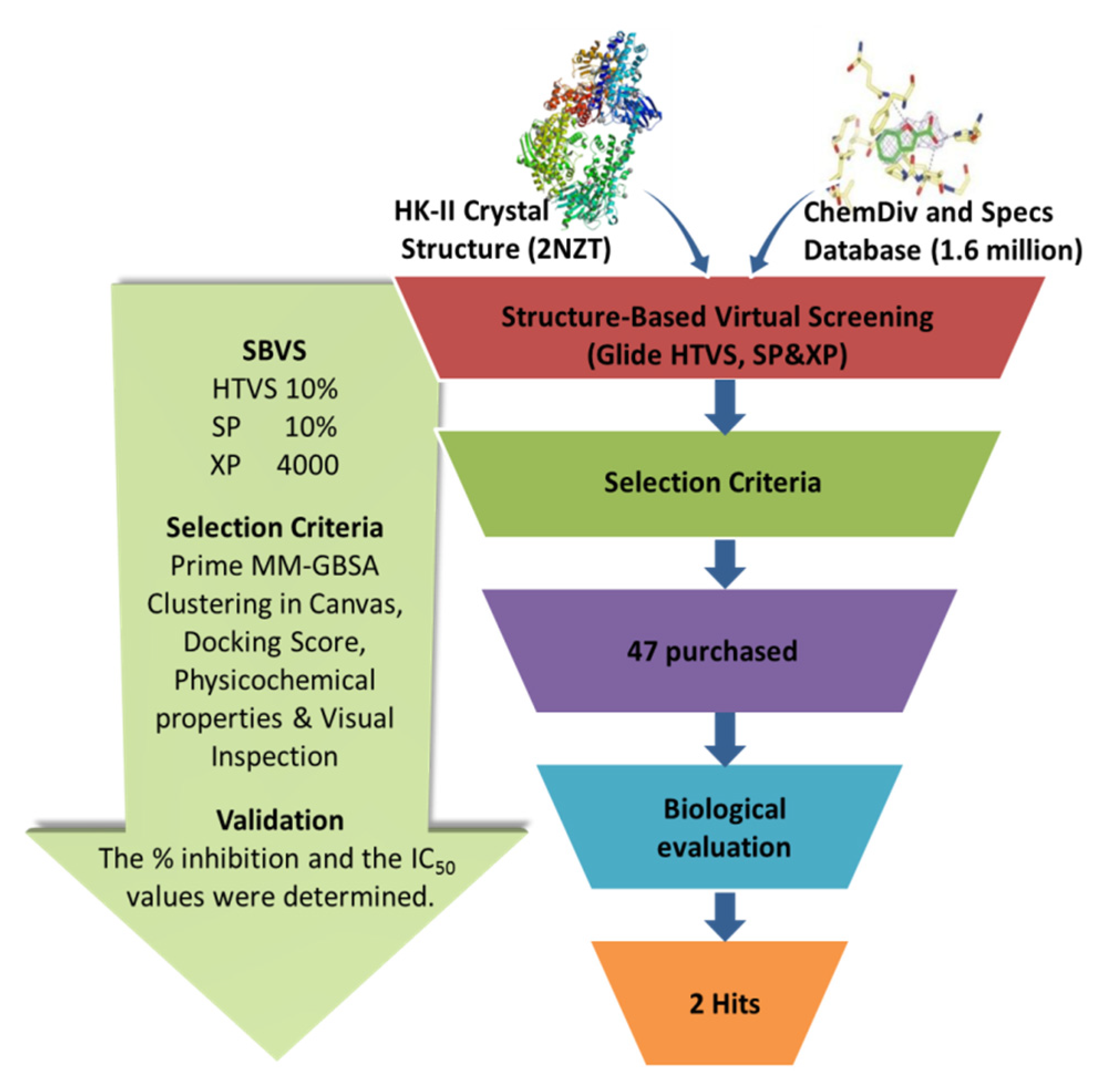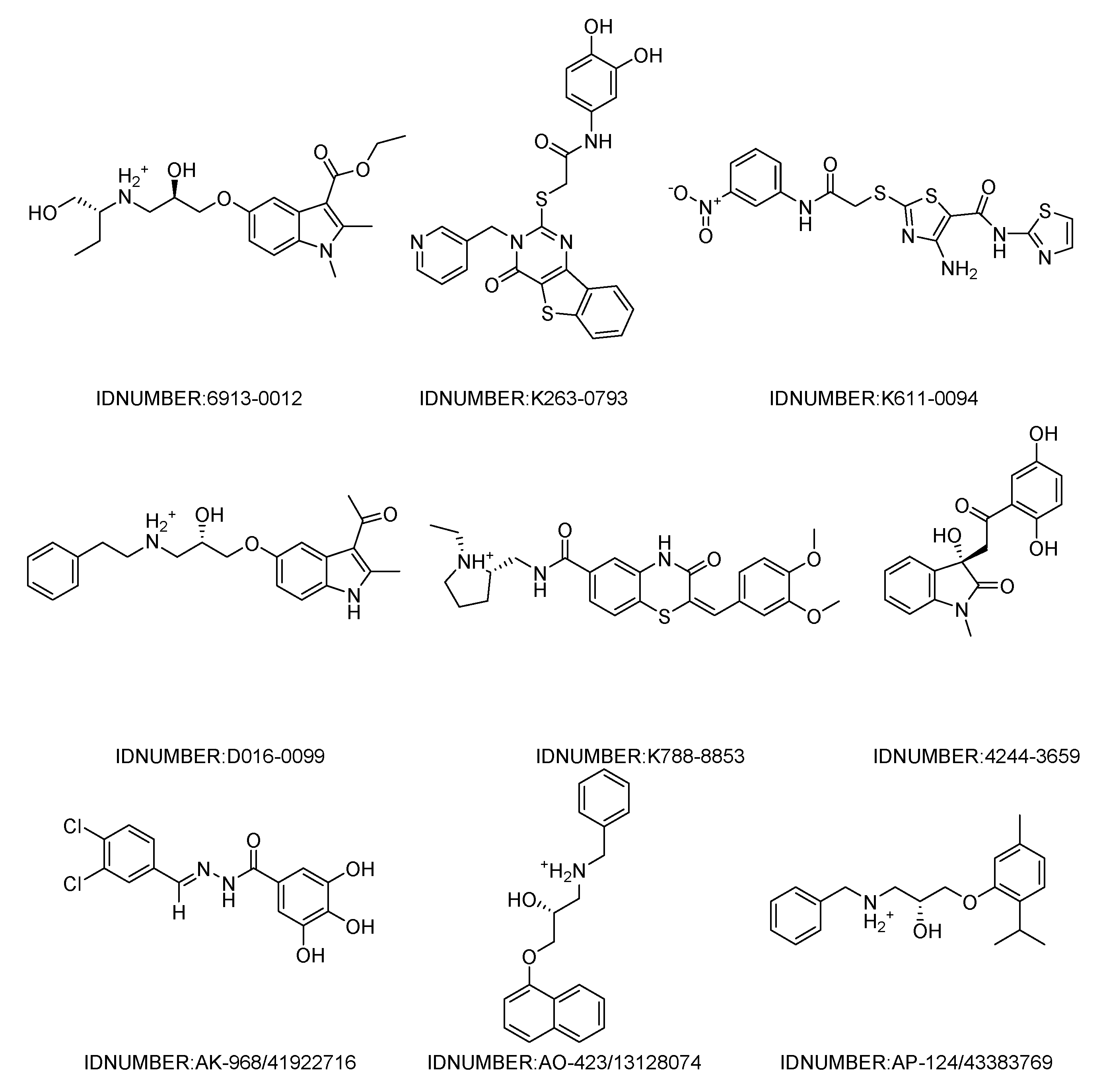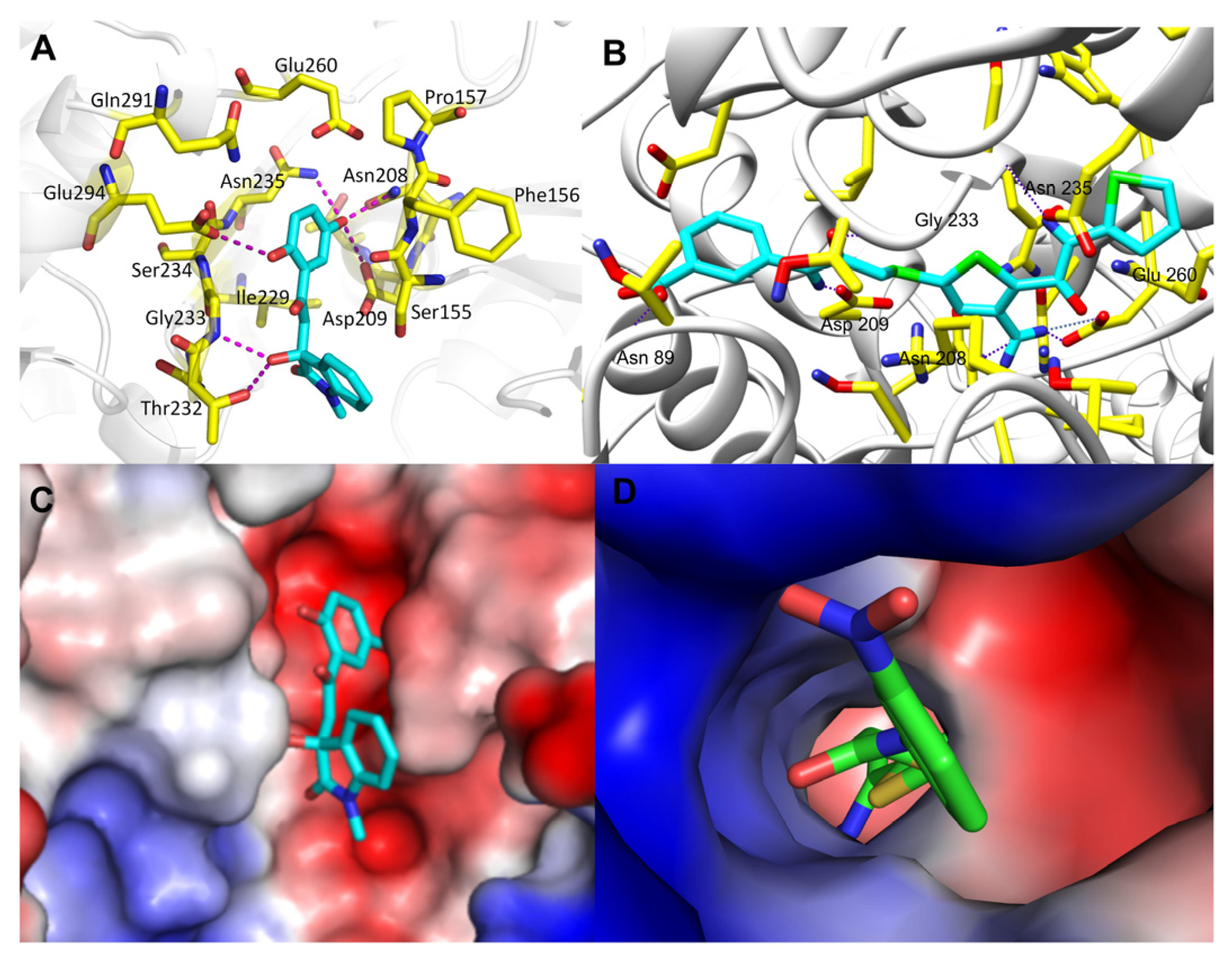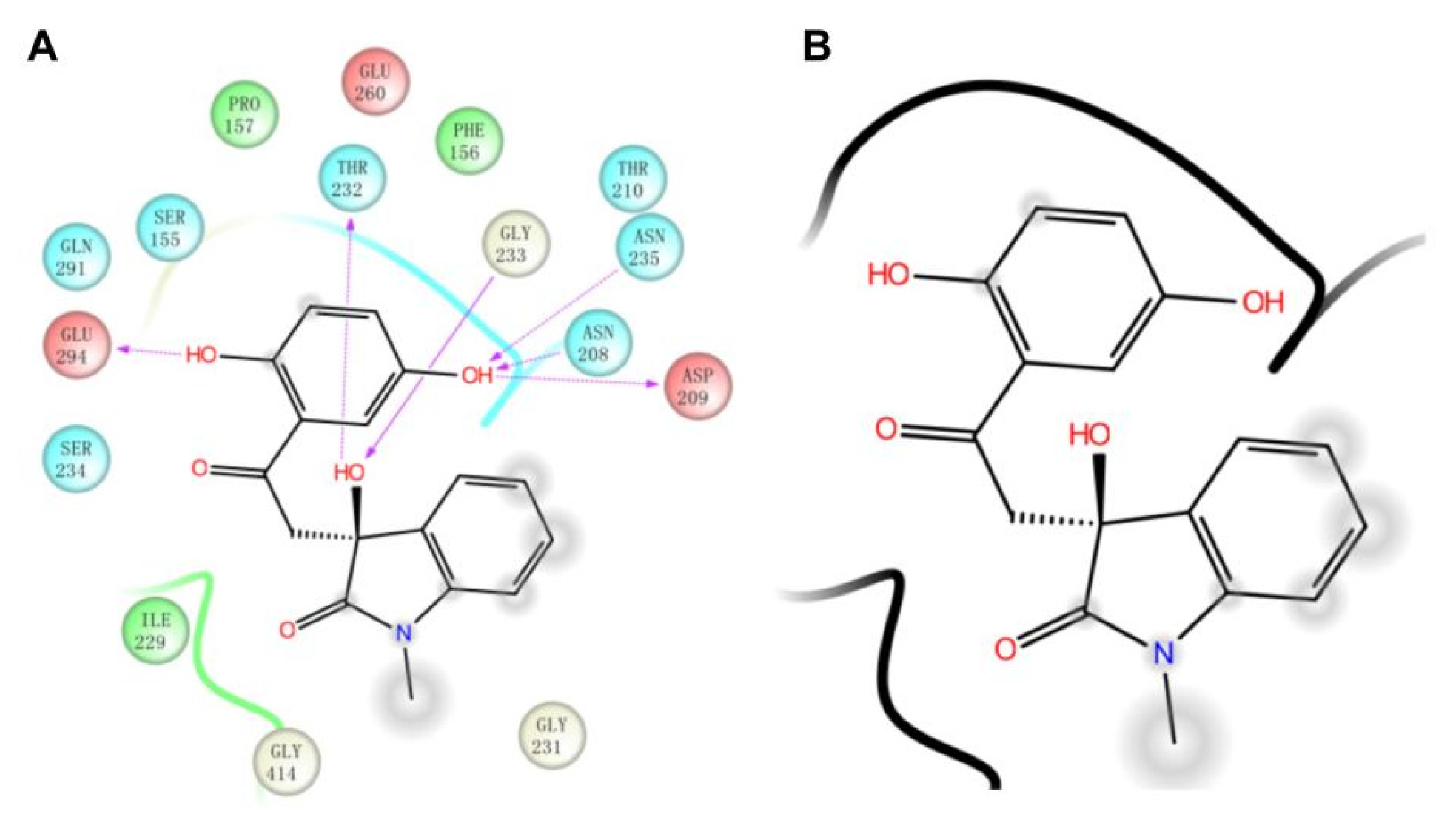Virtual Screening and Biological Activity Evaluation of New Potent Inhibitors Targeting Hexokinase-II
Abstract
1. Introduction
2. Results and Discussion
2.1. Virtual Screening and Initial Hit Evaluation
2.2. Hexokinase-II Activity
2.3. Structural Analysis of the Binding of Hit Molecules to HK-II
3. Materials and Methods
3.1. Docking-Based Virtual Screening
3.2. Chemicals and Enzymes
3.3. Cell lines and Culture Conditions
3.4. Cytotoxicity Assays
3.5. Hexokinase-II Activity
3.6. Statistical Analysis
4. Conclusions
Author Contributions
Funding
Institutional Review Board Statement
Informed Consent Statement
Data Availability Statement
Conflicts of Interest
Sample Availability
References
- Zu, X.L.; Guppy, M. Cancer metabolism: Facts, fantasy, and fiction. Biochem. Biophys. Res. Commun. 2004, 313, 459–465. [Google Scholar] [CrossRef] [PubMed]
- Janeway, K.A.; Kim, S.Y.; Lodish, M.; Nosé, V.; Rustin, P.; Gaal, J.; Dahia, P.L.; Liegl, B.; Ball, E.R.; Raygada, M.; et al. Defects in succinate dehydrogenase in gastrointestinal stromal tumors lacking KIT and PDGFRA mutations. Proc. Natl. Acad. Sci. USA 2011, 108, 314–318. [Google Scholar] [CrossRef] [PubMed]
- Mookerjee, S.A.; Gerencser, A.A.; Nicholls, D.G.; Brand, M.D. Quantifying intracellular rates of glycolytic and oxidative ATP production and consumption using extracellular flux measurements. J. Biol. Chem. 2017, 292, 7189–7207. [Google Scholar] [CrossRef] [PubMed]
- Vaupel, P.; Multhoff, G. Revisiting the Warburg effect: Historical dogma versus current understanding. J. Physiol. 2021, 599, 1745–1757. [Google Scholar] [CrossRef] [PubMed]
- Hay, N. Reprogramming glucose metabolism in cancer: Can it be exploited for cancer therapy? Nat. Rev. Cancer 2016, 16, 635–649. [Google Scholar] [CrossRef] [PubMed]
- Wilson, J.E. Isozymes of mammalian hexokinase: Structure, subcellular localization and metabolic function. J. Exp. Biol. 2003, 206, 2049–2057. [Google Scholar] [CrossRef]
- Mathupala, S.P.; Ko, Y.H.; Pedersen, P.L. Hexokinase-2 bound to mitochondria: Cancer’s stygian link to the “Warburg Effect” and a pivotal target for effective therapy. Semin. Cancer Biol. 2009, 19, 17–24. [Google Scholar] [CrossRef]
- Peng, Q.P.; Zhou, J.M.; Zhou, Q.; Pan, F.; Zhong, D.P.; Liang, H.J. Downregulation of the hexokinase II gene sensitizes human colon cancer cells to 5-fluorouracil. Chemotherapy 2008, 54, 357–363. [Google Scholar] [CrossRef]
- Tennant, D.A.; Durán, R.V.; Gottlieb, E. Targeting metabolic transformation for cancer therapy. Nat. Rev. Cancer 2010, 10, 267–277. [Google Scholar] [CrossRef]
- Zhang, Z.F.; Feng, X.S.; Chen, H.; Duan, Z.J.; Wang, L.X.; Yang, D.; Liu, P.X.; Zhang, Q.P.; Jin, Y.L.; Sun, Z.G.; et al. Prognostic significance of synergistic hexokinase-2 and beta2-adrenergic receptor expression in human hepatocelluar carcinoma after curative resection. BMC Gastroenterol. 2016, 16, 57. [Google Scholar] [CrossRef][Green Version]
- Palmieri, D.; Fitzgerald, D.; Shreeve, S.M.; Hua, E.; Bronder, J.L.; Weil, R.J.; Davis, S.; Stark, A.M.; Merino, M.J.; Kurek, R.; et al. Analyses of resected human brain metastases of breast cancer reveal the association between up-regulation of hexokinase 2 and poor prognosis. Mol. Cancer Res. MCR 2009, 7, 1438–1445. [Google Scholar] [CrossRef] [PubMed]
- Wu, J.; Hu, L.; Wu, F.; Zou, L.; He, T. Poor prognosis of hexokinase 2 overexpression in solid tumors of digestive system: A meta-analysis. Oncotarget 2017, 8, 32332–32344. [Google Scholar] [CrossRef] [PubMed]
- Patra, K.C.; Wang, Q.; Bhaskar, P.T.; Miller, L.; Wang, Z.; Wheaton, W.; Chandel, N.; Laakso, M.; Muller, W.J.; Allen, E.L.; et al. Hexokinase 2 is required for tumor initiation and maintenance and its systemic deletion is therapeutic in mouse models of cancer. Cancer Cell 2013, 24, 213–228. [Google Scholar] [CrossRef] [PubMed]
- Xi, F.; Ye, J. Inhibition of Lung Carcinoma A549 Cell Growth by Knockdown of Hexokinase 2 In Situ and In Vivo. Oncol. Res. 2016, 23, 53–59. [Google Scholar] [CrossRef]
- Marini, C.; Salani, B.; Massollo, M.; Amaro, A.; Esposito, A.I.; Orengo, A.M.; Capitanio, S.; Emionite, L.; Riondato, M.; Bottoni, G.; et al. Direct inhibition of hexokinase activity by metformin at least partially impairs glucose metabolism and tumor growth in experimental breast cancer. Cell Cycle. 2013, 12, 3490–3499. [Google Scholar] [CrossRef]
- Pollak, M.N. Investigating metformin for cancer prevention and treatment: The end of the beginning. Cancer Discov. 2012, 2, 778–790. [Google Scholar] [CrossRef]
- Salani, B.; Marini, C.; Rio, A.D.; Ravera, S.; Massollo, M.; Orengo, A.M.; Amaro, A.; Passalacqua, M.; Maffioli, S.; Pfeffer, U.; et al. Metformin impairs glucose consumption and survival in Calu-1 cells by direct inhibition of hexokinase-II. Sci. Rep. 2013, 3, 2070. [Google Scholar] [CrossRef]
- Ben Sahra, I.; Laurent, K.; Giuliano, S.; Larbret, F.; Ponzio, G.; Gounon, P.; Le Marchand-Brustel, Y.; Giorgetti-Peraldi, S.; Cormont, M.; Bertolotto, C.; et al. Targeting cancer cell metabolism: The combination of metformin and 2-deoxyglucose induces p53-dependent apoptosis in prostate cancer cells. Cancer Res. 2010, 70, 2465–2475. [Google Scholar] [CrossRef]
- Singh, D.; Banerji, A.K.; Dwarakanath, B.S.; Tripathi, R.P.; Gupta, J.P.; Mathew, T.L.; Ravindranath, T.; Jain, V. Optimizing cancer radiotherapy with 2-deoxy-d-glucose dose escalation studies in patients with glioblastoma multiforme. Strahlenther. Und Onkol. 2005, 181, 507–514. [Google Scholar] [CrossRef]
- Pedersen, P.L. 3-Bromopyruvate (3BP) a fast acting, promising, powerful, specific, and effective “small molecule” anti-cancer agent taken from labside to bedside: Introduction to a special issue. J. Bioenerg. Biomembr. 2012, 44, 1–6. [Google Scholar] [CrossRef]
- Li, W.; Zheng, M.; Wu, S.; Gao, S.; Yang, M.; Li, Z.; Min, Q.; Sun, W.; Chen, L.; Xiang, G.; et al. Benserazide, a dopadecarboxylase inhibitor, suppresses tumor growth by targeting hexokinase 2. J. Exp. Clin. Cancer Res. CR 2017, 36, 58. [Google Scholar] [CrossRef] [PubMed]
- Liu, Y.; Li, M.; Zhang, Y.; Wu, C.; Yang, K.; Gao, S.; Zheng, M.; Li, X.; Li, H.; Chen, L. Structure based discovery of novel hexokinase 2 inhibitors. Bioorg. Chem. 2020, 96, 103609. [Google Scholar] [CrossRef]
- Zheng, M.; Wu, C.; Yang, K.; Yang, Y.; Liu, Y.; Gao, S.; Wang, Q.; Li, C.; Chen, L.; Li, H. Novel selective hexokinase 2 inhibitor Benitrobenrazide blocks cancer cells growth by targeting glycolysis. Pharmacol. Res. 2021, 164, 105367. [Google Scholar] [CrossRef] [PubMed]
- Hernandez, J.J.; Pryszlak, M.; Smith, L.; Yanchus, C.; Kurji, N.; Shahani, V.M.; Molinski, S.V. Giving Drugs a Second Chance: Overcoming Regulatory and Financial Hurdles in Repurposing Approved Drugs as Cancer Therapeutics. Front. Oncol. 2017, 7, 273. [Google Scholar] [CrossRef] [PubMed]
- Friesner, R.A.; Banks, J.L.; Murphy, R.B.; Halgren, T.A.; Klicic, J.J.; Mainz, D.T.; Repasky, M.P.; Knoll, E.H.; Shelley, M.; Perry, J.K.; et al. Glide: A new approach for rapid, accurate docking and scoring. 1. Method and assessment of docking accuracy. J. Med. Chem. 2004, 47, 1739–1749. [Google Scholar] [CrossRef]





| Database | acceptHB a | donorHB b | Docking Score c | Prime MM-GBSA (kcal/mol) | |
|---|---|---|---|---|---|
| Chemdiv | 6913-0012 | 7.65 | 3 | −8.5291 | −46.0649 |
| K263-0793 | 9.5 | 3 | −8.0771 | −60.5486 | |
| K611-0094 | 8.5 | 3 | −7.8236 | −52.1084 | |
| D016-0099 | 4.95 | 2 | −7.3413 | −43.2341 | |
| K788-8853 | 8.5 | 2 | −7.2758 | −47.5018 | |
| 4244-3659 | 5.25 | 1 | −7.1817 | −42.5366 | |
| Specs | AK-968/41922716 | 4.75 | 4 | −7.0789 | −47.2578 |
| AO-423/13128074 | 3.95 | 2 | −6.6181 | −38.1110 | |
| AP-124/43383769 | 3.95 | 2 | −6.3516 | −38.7376 | |
| Database | IC50 (μM) a | |||
|---|---|---|---|---|
| Hela | HepG 2 | A549 | ||
| Chemdiv | 6913-0012 | 51.9 ± 1.5 | 59.0 ± 0.2 | 62.6 ± 0.7 |
| K263-0793 | 22.4 ± 1.4 | 22.1 ± 0.9 | 27.1 ± 1.4 | |
| K611-0094 | 47.8 ± 0.6 | 57.9 ± 1.7 | 48.8 ± 1.2 | |
| D016-0099 | 48.5 ± 1.2 | 44.2 ± 0.6 | 50.4 ± 0.3 | |
| K788-8853 | 15.1 ± 0 | 12.0 ± 0.5 | 10.7 ± 0.5 | |
| 4244-3659 | 62.1 ± 2.0 | 62.5 ± 2.1 | 54.6 ± 2.6 | |
| Specs | AK-968/41922716 | 28.5 ± 1.9 | 40.0 ± 0.2 | 31.0 ± 0 |
| AO-423/13128074 | 27.7 ± 0.6 | 30.0 ± 1.4 | 38.6 ± 0.8 | |
| AP-124/43383769 | 25.1 ± 0.9 | 23.3 ± 0 | 36.5 ± 0.4 | |
| Database | EC50 (μM) | |
|---|---|---|
| Chemdiv | 6913-0012 | 151.7 ± 1.1 |
| K263-0793 | 156.3 ± 1.1 | |
| K611-0094 | 45.0 ± 1.1 | |
| 4244-3659 | 17.5 ± 1.4 | |
| Specs | AO-423/13128074 | 153.8 ± 1.2 |
| AP-124/43383769 | 103.8 ± 1.1 | |
Publisher’s Note: MDPI stays neutral with regard to jurisdictional claims in published maps and institutional affiliations. |
© 2022 by the authors. Licensee MDPI, Basel, Switzerland. This article is an open access article distributed under the terms and conditions of the Creative Commons Attribution (CC BY) license (https://creativecommons.org/licenses/by/4.0/).
Share and Cite
Liu, R.; Liu, X. Virtual Screening and Biological Activity Evaluation of New Potent Inhibitors Targeting Hexokinase-II. Molecules 2022, 27, 7555. https://doi.org/10.3390/molecules27217555
Liu R, Liu X. Virtual Screening and Biological Activity Evaluation of New Potent Inhibitors Targeting Hexokinase-II. Molecules. 2022; 27(21):7555. https://doi.org/10.3390/molecules27217555
Chicago/Turabian StyleLiu, Ruijuan, and Xuewei Liu. 2022. "Virtual Screening and Biological Activity Evaluation of New Potent Inhibitors Targeting Hexokinase-II" Molecules 27, no. 21: 7555. https://doi.org/10.3390/molecules27217555
APA StyleLiu, R., & Liu, X. (2022). Virtual Screening and Biological Activity Evaluation of New Potent Inhibitors Targeting Hexokinase-II. Molecules, 27(21), 7555. https://doi.org/10.3390/molecules27217555






